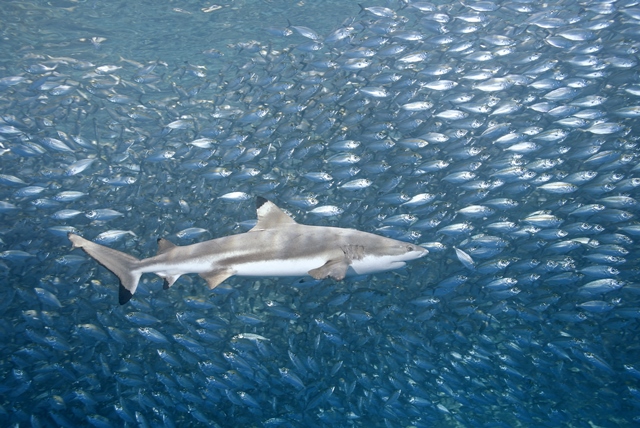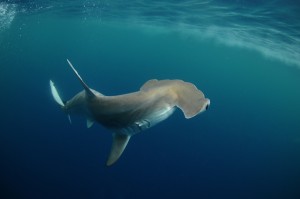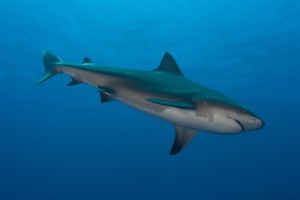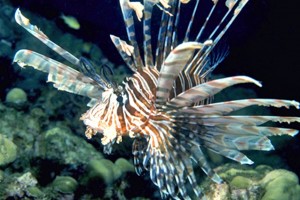
by Rick O'Connor | Aug 8, 2014
Since the beginning of the summer, panhandle residents and visitors have been reporting numerous sharks hanging out along the sandbars near the passes. , cruising between the 2nd sandbar and the beach. One visitor was even bitten; raising the question – WHAT’S UP WITH ALL THE SHARKS?

The Scalloped Hammerhead is one of five species of hammerheads in the Gulf. It is commonly found in the bays. Photo: Florida Sea Grant
Actually, over the years sharks have been feeding along on the sandbars. While tagging sharks at Dauphin Island Sea Lab we would send an ultralite aircraft up to spot their locations. The pilot often reported seeing sharks hanging out on the sandbars near the pass. The sharks generally moved slowly until the shadow of the aircraft would hit and spook them into swimming off. Surfers and fishermen alike know that sharks frequent the inshore waters near the beach during the warmer months. Some or the larger sharks certainly enter the bays where feeding and breeding probably occur. So, finding them in these locations is not that unusual.
What seems to be unusual this year are the numbers. Locals who have worked these waters for years say they have seen more sharks on the sandbars than they remember in the past. We do not have data on how many sharks typically are found on bars, so there’s no conclusive proof that the number seen this summer is significantly more. However, if the folks out there every day say they are seeing more, then there may be something to it.
The gathering of sharks may be due to feeding. Like any other animal, they gather where the food is. I have seen Jack Crevalle gather at the mouths of our bayous feeding after a fish kill. The big flood this summer dropped salinities below normal and many estuarine animals died; Big Lagoon was littered with dead clams. It is possible that the sharks are feeding on these with the outgoing tides. If there is more food there would be more sharks. Another possible explanation could be temperature control. Like all fish, sharks are ectothermic (cold-blooded) and need warm water to keep maintain their body temperature. Divers searching for lionfish this spring indicated that the bottom temperatures have been colder than normal this year; again, possibly due to the flood waters or an upwelling from the deeper Gulf. The sharks may be gathering where warmer water can be found: shallow water over bars. Outside of nurse and lemon shark species, breeding in sharks has rarely been observed. However, now is the time of year when this occurs and the National Marine Fisheries has considered the estuaries of the northern Gulf potential breeding areas for some species of shark.

The Bull Shark is considered one of the more dangerous sharks in the Gulf. This fish can enter freshwater but rarely swims far upstream. Photo: Florida Sea Grant
As far as the threat of attacks are concerned, there is really not a high risk. Certainly sharks in feeding mode in shallow water could be a potential threat. But according to the International Shark Attack File at the Florida Museum of Natural History only 21 attacks have occurred in panhandle waters since 1882 and 2 were fatal; 1 in Bay County (1988) and 1 in Walton (2005) . Following some simple rules will reduce your risk of shark bite. Swimming in or near baitfish or where recreational fishing is going on could increase your chances; avoid these. Though shark attacks occur all hours of the day and night there seems to be more during dawn and dusk, as these are their primary feeding times. Lifeguards along the coast are constantly watching for these fish along with other hazards. Following these simple rules should allow you to enjoy the water without concern. If you have any questions about sharks contact your county Sea Grant Extension Agent.

by Rick O'Connor | Nov 22, 2013
It seems everyone in the Panhandle is talking about the invasive lionfish. This non-native member of the scorpionfish family was first seen in U.S. waters in 1989 near Ft. Lauderdale. Over the last two decades, much has been learned about the biology and potential impacts of lionfish in our waters; For additional background information you can read more at these websites http://myfwc.com/wildlifehabitats/nonnatives/marine-species/lionfish and http://escambia.ifas.ufl.edu/marine/2012/08/17/the-invasion-of-the-lionfish
This past October, the Florida Fish and Wildlife Conservation Commission held the first state lionfish summit in Cocoa Beach. Researchers, fishery managers, divers, fishermen, and the general public received research updates, discussed current issues, and provided input regarding future management needs. Here are a few of the interesting highlights from the summit.

Red Lionfish
Photo: Florida Sea Grant
What are the potential problems?
- Several theories on how lionfish were initial released into state waters have been suggested. However, research results now indicate a single introduction of lionfish in Florida initiated the invasion into the Western Atlantic presumably from just a few aquarium specimens.
- Sixty-thousand lionfish continue to be imported into the state each year.
- Compared to native Pacific population, Florida densities of lionfish are much higher; 400 fish/hectare in Florida compared to 80 fish/hectare in the Pacific. On average, invasive Atlantic Lionfish individuals are larger than the native populations in the Pacific basin.
- Studies from Pensacola showed that lionfish population has doubled annually since 2010 and lionfish densities are highest on artificial reefs.
- Invasive lionfish have no natural predators and may spawn 30,000 – 40,000 eggs every 2 to 4 days.
- Another potential problem reported are records of lionfish entering the Loxahatchee and Indian Rivers; indicating that they are able to move into brackish water.
What are the negative impacts?
Young lionfish feed primarily on crustaceans and when they are older they prey on reef fish. Research and stomach analysis indicate 70 different reef fish species as potential prey. Lobster fishermen in the Keys found lionfish are the leading by-catch species and have reduced lobster harvest by as much as 50%. Another study indicates lionfish on natural reefs they prefer blennies. However, on artificial reefs they feed on small snappers, sea bass, and groupers. Finally, an interesting study compared primary reef predators. Reefs with only grouper there was a 36% decrease of juvenile fish while reefs with lionfish the decrease was 94%.
What can be done?
Several reports indicate that collecting tournaments are effective; Lad Akins of Reef Environmental Education Foundation (www.reef.org) reported a 69% reduction of lionfish from one event in Key Largo. Another study had similar results but indicated that some spear fishermen were more successful than others, suggesting training may be required to increase efficiency.
Other reports indicate that work where native fish were introduced and conditioned to consume lionfish have led these native predators to follow and even bite divers thinking that “free food” may be available; it was suggested that this idea not be pursued.
Locally, lionfish rodeos sponsored by Emerald Coast Reef Association occur frequently in Okaloosa County. Escambia County Marine Resources hosted a pilot event this summer. Escambia will begin a full lionfish control program in 2014. If you have questions or comments, please contact your local UF/IFAS natural resource or Sea Grant Extension Agent.
Please note: UF/IFAS and Florida Sea Grant does not organize volunteers to participate in local lionfish control events; this is done by independent community groups. UF/IFAS and Florida Sea Grant provides this information about food safety concerns associated with eating lionfish. Click here for more information.
by Scott Jackson | Oct 25, 2012

Save the date for the Florida Sea Grant-FWC Artificial Reef Workshop on Feb. 19-20 in Niceville. (Photo courtesy Bill Horn, FWC)
Please save the date for the 2013 Northwest Florida Regional Artificial Reef Workshop sponsored by Florida Sea Grant and FWC, to be held at the Niceville Community Center in Niceville, FL on Wednesday-Thursday, February 19-20, 2013. (Change due to Gulf Council Meeting Date Conflict)
Agenda and Registration Information to be released Dec 14 or earlier.






